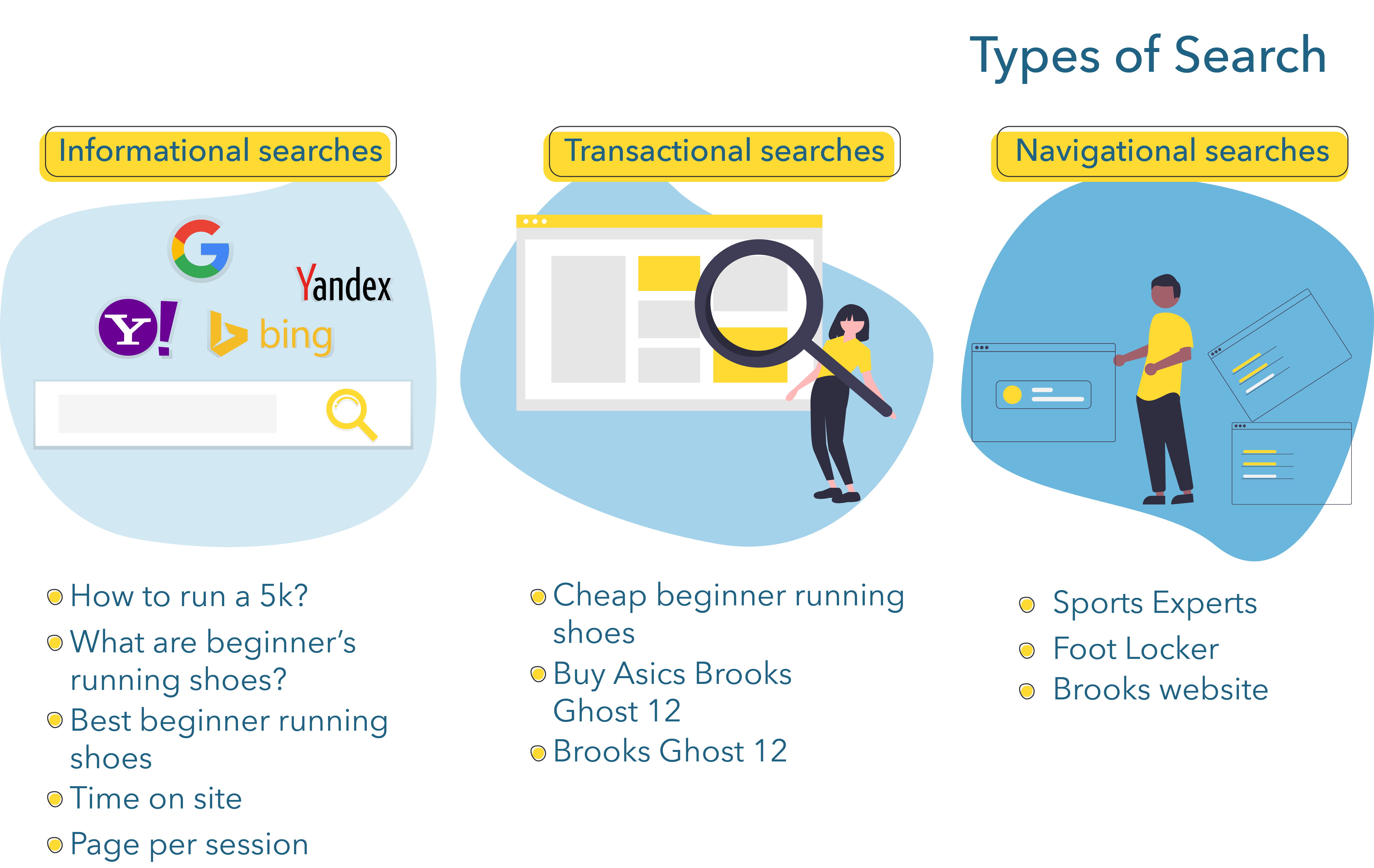Understanding How Consumers Use Keywords
Since user experience is central to ranking high, it becomes quite important to understand how people search for stuff online. We are going to talk about three ways of thinking about this.
A first way of thinking about how people search is to consider the objective of their search. Three types of searches are typically referred to by SEO professionals (e.g., Moz 2016; Figure 3.6).
Consumers perform informational searches when they are looking for information about a specific topic. Examples might include
- “How to run a 5k?”
- “What are beginner’s running shoes?” or
- “Best beginner running shoes.”
Consumers perform transactional searches when they are looking to perform a transaction. Transactions have been both narrowly defined (i.e., buying a product) and more broadly defined (i.e., performing an interaction). Examples of transactional searches might be
- “Cheap beginner running shoes”
- “Brooks Ghost 12” or
- “Buy Asics Brooks Ghost 12.”
Consumers perform navigational searches when they are looking for a specific website. Such a search might look like
- “Sports Experts”
- “Foot Locker” or
- “Brooks website.”
Considering the objectives of people performing search queries is helpful for us as digital marketers because it allows us to create webpages to answer these specific objectives. The kind of keywords on each page will be vastly different.
These objectives can also be placed in a process, where someone moves from needing information about a specific need or challenge to wanting to perform interactions (or a transaction) to address this need to wanting to visit a specific website.
The key idea here is that, as digital marketers, knowing why people are searching for something allows you to create pages that more directly align with their searches. This helps you improve user experience and choose the right keywords, both of which should allow your webpages to rank higher.
Figure 3.6 Types of Search

A second way to think about why people are searching is to start with their needs, challenges, and goals. This has a few implications: First, as we have seen with RV Betty, different segments/personas have different needs, challenges, and goals. That means that you will need to create different webpages to attract different personas to your website, where each webpage should address a specific need, challenge, or goal (and, perhaps, could do so by targeting different search objectives). Thus, when creating webpages, the first questions that should come to your mind are the following: What are the needs of my persona? What goal are they trying to achieve? What challenges are they facing when trying to address their need or achieve their goal? Answering these questions should allow you to generate many different content ideas, from which you can think of specific search queries. We will cover this in more detail when we talk about content marketing. In this course, we will emphasize how consumers’ searches vary depending on where they are in their journey:
- Early on in their journey, consumers are looking to find information about a problem they are facing or a need they are trying to address (e.g., “how to run a 5k,” “treating acne fast,” “easy ways to gain muscle,” or “getting a job after college”).
- As consumers move to actively evaluating the options available to address their need, they will start to weigh different options (e.g., “best training plan for 5k,” “retinol vs. benzoyl vs. salicylic,” “is creatine that good,” or “should I register on linkedin”).
- Lastly, once they are closer to making a purchase, they will look at evaluating or accessing the specific product they choose (e.g., “sales brooks ghost 12,” “where to buy benzoyl,” “creatine online cheap,” “linkedin promo code”).
Similarly to the three objectives of searches, knowing that consumers first concentrate on problems, then on potential solutions, and finally on the product or service they are interested in is the first step to creating a marketing campaign. Keeping in mind that our goal is to create value for consumers by representing them (rather than talking about our company), this means that we will need to create ads and content that (1) inform consumers about their problems, (2) help them evaluate their options, and (3) position our product as the best or create product or service-specific information. When we introduce the conversion-based framework in the next chapter, we will see how each of these stages can also be used for different strategic goals (namely, attracting visitors, converting visitors to leads, and converting leads to customers). This is visually represented in Figure 3.7 below.
Figure 3.7 Journey and Searches

We will cover the last way to think about searches very briefly, since we discussed it in the last chapter: Google ZMOTs. As we saw, Google proposes four ZMOTs: I want to know, I want to go, I want to do, and I want to buy. Some of these overlap with what we just saw. I-want-to-know searches are informational searches. I-want-to-buy searches can be thought of as transactional searches (a broader definition of transactional searches could also include I-want-to-do searches). These moments again present opportunities to create content. Google presents numerous ways for marketers to capitalize on I-want-to-do moments here.
